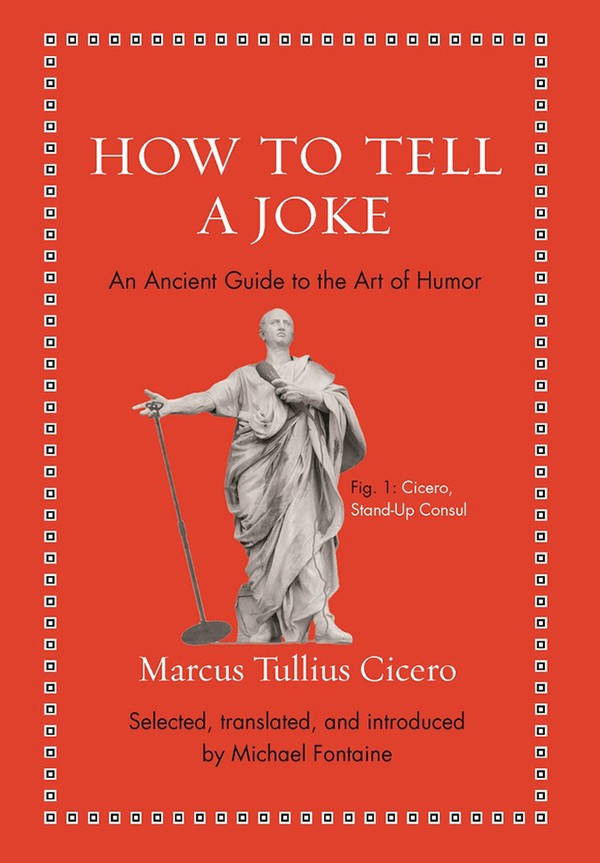Translation updates Cicero’s treatise on jokes as ‘weapons’
By Linda B. Glaser
“Memmius thinks he’s such a towering figure that when he comes into the Forum, he has to duck under the Fabian arch,” quipped Cicero, a pointed joke that still works more than 2,000 years later.
Michael Fontaine’s lively new translation of Cicero’s ancient text on humor, “How to Tell a Joke: An Ancient Guide to the Art of Humor,” amuses as well as instructs – as Cicero, called by his enemies “the stand-up Consul,” no doubt intended.
Cicero’s treatise is part of his longer masterpiece, “On the Ideal Orator”, written in 55 BCE. Fontaine’s book also includes Quintilian’s humor treatise, part of his “The Education of the Orator,” written in 95 CE.
In his introduction, Fontaine writes that both Cicero and Quintilian thought of humor as a source of power – jokes not just as entertainment, but as “weapons of war.”
According to Fontaine, Cicero proved that jokes are not just for fun: “His enemies said, this guy's a total buffoon. He’s a clown. He’s telling jokes, he breaks protocol. And yet he keeps winning and winning and winning,” Fontaine said.
“How to Tell a Joke” was commissioned during the last presidential campaign cycle, which Fontaine said felt quite timely. The text is all about how to use humor to get ahead, to win elections and trials – “It’s ‘How to Win Friends and Influence People’ using humor,” said Fontaine, professor of classics in the College of Arts and Sciences.
While Cicero used his techniques as both a politician and a lawyer, Quintilian was an academic who “didn't really have the guts to tell a joke in a murder trial,” Fontaine said. He noted that the difference in their approaches was probably due to their political environment: Cicero lived in the late Roman Republic when free speech could win elections, while Quintilian came of age in an autocracy, where saying what you think could lead to trouble.
“The palpable difference in how they handle these jokes has relevance today,” said Fontaine. “Cicero’s time was the equivalent of pre-social media, whereas Quintilian’s more aware that you have to think long-term about these jokes, as though they could live forever on Instagram or Twitter.”
As Quintilian wrote, “humor is risky, since ‘wit’ is so close to ‘twit.’”
Capturing the humor in the texts made it the most difficult translation Fontaine has ever done, and he understands why earlier translations did not even try to make the humor accessible. He drew heavily on modern idiomatic expressions to communicate meaning.
“The whole point of my translation is to make it funny the way the authors intended,” said Fontaine, who sometimes had to go for the sense of the wordplay rather than its literal meaning. “In some cases, though, the colloquialisms I used reflect exactly what the Latin says.”
Fontaine believes so strongly of the value in these humor techniques for getting ahead that he has teamed up with eCornell to develop two courses for their executive education series. “These are all algorithms that work – timeless, proven techniques,” he said.
Despite their effectiveness, though, Fontaine noted that Cicero’s humor is occasionally offensive. “Even for his own time and place, as this book shows, Cicero sometimes took it way too far,” said Fontaine. “In recognizing the power of his techniques, it’s also important to recognize that Cicero himself was a flawed individual, even though we can still draw important lessons from his writing.”
“How to Tell a Joke” is part of Princeton University Press’ series of “how to” texts from antiquity. Fontaine’s previous contribution, “How to Drink,” proved highly popular; German and Turkish translations are underway. His next for the series, also by Cicero, will be a text on how to grieve – particularly appropriate for the current times, he added.
Fontaine will speak on “How to Tell a Joke” in a Chat in the Stacks at the Cornell Library on March 24 at 4 p.m. and in an eCornell keynote talk April 1.
Linda B. Glaser is news and media relations manager for the College of Arts and Sciences.
Media Contact
Get Cornell news delivered right to your inbox.
Subscribe
